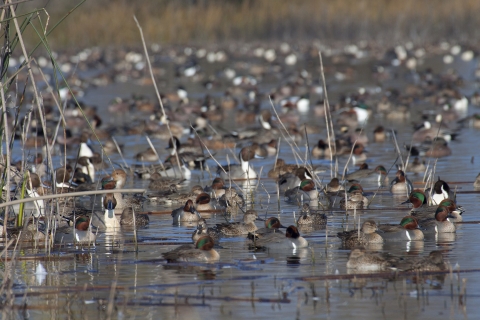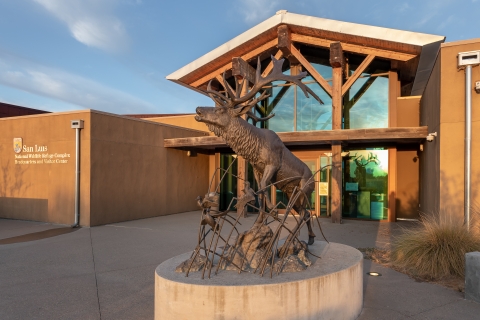About Us
The San Luis National Wildlife Refuge encompasses over 26,800 acres of wetlands, riparian riparian
Definition of riparian habitat or riparian areas.
Learn more about riparian woodlands, native grasslands, and vernal pools. A thriving population of endemic tule elk is showcased on one of three auto tour routes. The refuge is host to significant assemblages of birds, mammals, reptiles, amphibians, fish, insects, and plants; some of which, such as the California tiger salamander, the long-horned fairy shrimp, and San Joaquin kit fox, are endangered species.
The San Luis National Wildlife Refuge was established in 1967 under the Migratory Bird Conservation Act. The first refuge parcel was purchased with federal Duck Stamp funds to serve as inviolate sanctuary for migratory waterfowl. The refuge has grown over the years and today it is comprised of six contiguous units: San Luis, East Bear Creek, West Bear Creek, Freitas, Blue Goose, and Kesterson. The eastern portion of the refuge is bisected by the San Joaquin River.
The refuge is a major wintering ground and migratory stopover point for large concentrations of waterfowl, shorebirds, and other waterbirds. From autumn through spring, the wetlands on the refuge come alive as large numbers of migrating waterfowl, shorebirds, and wading birds arrive in the San Joaquin Valley. Here, the wetlands provide plentiful food and shelter, and a critical wintering area along the Pacific Flyway migration route. The wetlands also support a wide variety of other animals, including mammals, amphibians, reptiles, and insects. Waterfowl generally remain until late March before beginning their journey back north to breeding areas; however, some mallard, gadwall, and cinnamon teal remain in the area to nest and raise young.
Shorebirds, including species of sandpipers and plovers can be found in the tens of thousands from autumn through spring. Large flocks of dunlin, long-billed dowitchers, least sandpipers, and western sandpipers can be seen feeding in shallow seasonal wetlands. Flocks of long-billed curlews are found using both wetlands and grasslands. More than 25 species of shorebirds have been documented at the refuge.
The San Luis NWR has played a key role in the recovery of tule elk, a non-migratory elk subspecies found only in California. Prior to the mid-1800s, an estimated 500,000 tule elk lived in California. Due to over hunting and loss of natural habitat, they were nearly driven to extinction by the turn of the 20th century – by some accounts, the population was reduced to as few as 20-30 individuals. In 1974 a herd of 18 animals was established in a large enclosure at refuge and has since thrived. Elk from this herd are periodically relocated to join other tule elk herds, or establish new ones, throughout California.
Less well-known are the extensive upland habitats found on the refuge. Many of these habitats are characterized by saline and alkaline conditions in conjunction with low rainfall and an arid climate that characterize the San Joaquin Valley. These habitats support a rich botanical community of native bunchgrasses, native and exotic annual grasses, forbs, and native shrubs. Trees, such as the valley oak, cottonwood, and willow are found along riparian corridors. In these areas, visitors might encounter coyotes, desert cottontail rabbits, ground squirrels, western meadowlarks, yellow-billed magpies, and loggerhead shrikes, as well as northern harriers, white-tailed kites, and other raptors coursing over the vegetation.
The refuge is home to the complex’s visitor center and headquarters, which features an exhibit hall with interactive educational exhibits about wildlife and habitats and a classroom for conducting environmental education fieldtrips for visiting schools.
The refuge has three auto tour routes with associated nature trails and observation platforms from which the public can view and photograph wildlife and nature. The refuge also allows fishing at designated sites and has a large waterfowl hunting program.
Our Mission
The mission of the National Wildlife Refuge System is to administer a national network of lands and waters for the conservation, management and, where appropriate, restoration of the fish, wildlife and plant resources and their habitats within the United States for the benefit of present and future generations of Americans.
Every national wildlife refuge national wildlife refuge
A national wildlife refuge is typically a contiguous area of land and water managed by the U.S. Fish and Wildlife Service for the conservation and, where appropriate, restoration of fish, wildlife and plant resources and their habitats for the benefit of present and future generations of Americans.
Learn more about national wildlife refuge was created for a special purpose. Some were created to protect migratory birds, others to protect threatened or endangered species or unique habitats, while others fulfill another special purpose. All activities allowed on refuges must be evaluated to make sure each activity will not conflict with the reason the refuge was founded.
The San Luis National Wildlife Refuge was established in 1967 under the Migratory Bird Conservation Act. The first refuge parcel was purchased with federal Duck Stamp funds to serve as inviolate sanctuary for migratory waterfowl. The Migratory Bird Hunting and Conservation Act uses money from Duck Stamp sales to purchase refuge lands. Many lands purchased with Duck Stamp funds were defined as inviolate sanctuaries. These lands, under most circumstances, must be at least partially closed to migratory bird hunting to allow birds a place of refuge and protection.
Our History
1966 – The first parcel of the refuge was purchased using Duck Stamp funds.
1967 – The refuge was established under the Migratory Bird Conservation Act as inviolate sanctuary for migratory waterfowl.
1974 – The tule elk herd on the refuge was established.
2011 – The visitor center and headquarters on the refuge was completed and opened to the public.
Other Facilities in this Complex
The San Luis NWR is part of the San Luis NWR Complex. A national wildlife refuge national wildlife refuge
A national wildlife refuge is typically a contiguous area of land and water managed by the U.S. Fish and Wildlife Service for the conservation and, where appropriate, restoration of fish, wildlife and plant resources and their habitats for the benefit of present and future generations of Americans.
Learn more about national wildlife refuge complex is an administrative grouping of two or more refuges, wildlife management areas or other refuge conservation areas that are primarily managed from a central office location. Refuges are grouped into a complex structure because they occur in a similar ecological region, such as a watershed or specific habitat type, and have a related purpose and management needs. Typically, a project leader or complex manager oversees the general management of all refuges within the complex and refuge managers are responsible for operations at specific refuges. Supporting staff, composed of administrative, law enforcement, refuge manager, biological, fire, visitor services, and maintenance professionals, are centrally located and support all refuges within the complex.
Other units in the San Luis NWR Complex include the Merced NWR, San Joaquin River NWR, and Grasslands Wildlife Management Area.







